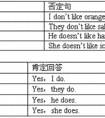用所给动词的适当形式填空。1. I prefer(be) in the countryside for a relaxation.2. Malls are usually very_____ (crowd) on the weekends.3. Let's go and see wh-九年级英语
Do you have anything else to say?
10.由两个或两个以上的词组成的形容词词组修饰名词时须放在名词之后。
This is the book easy to read.
这是一本容易读的书。
名词化的形容词:
有些形容词可以和定冠词连用,表示一类人或事物,这时,它相当于一个名词,可作主语或宾语;
表示一类人时,看作复数,表示一类事物时,通常看作单数。
Robin Hooh(罗宾汉) hated the rich and loved the poor.
The old are taken good care of in American.
the+形容词,常见的短语有:
the old/the young/the sick/the white/
the black/the rich/the poor/the dead(死者)
形似副词的形容词:
以-ly结尾的词通常是副词,但是下列词为形容词。
friendly lonely (孤独的) ;lively (活着的);lovely(可爱的)
复合形容词的类型:
(1)名词+过去分词 man-made satellite 人造卫星
(2)形容词+现在分词 a good-looking man
(3)形容词+名词 second-hand cars
(4)数词+名词-ed three-legged chairs三条腿的椅子
(5)数词+名词 400- metre race
(6)副词+现在分词 hard-working students
(7)副词+过去分词 well-known writers
(8)形容词+形容词 a dark-red jacket
(9)形容词+过去分词 ready-made clothes 成品服装
含有形容词的常用句型:
(1) It’s+adj. of sb. to do sth.
(good/ kind/nice/polite/clever/foolish… )
It’s very kind of you to help me.
(2) It’s +adj. for sb. to do sth.
(difficult/easy/hard/dangerous/usefulinteresting/important…)
It’s important for us to learn English well.
(3)下列形容词后常跟动词不定式
表示情感或情绪的形容词:glad,pleased,sorry,sad,afraid,thankful…
I'm glad to see you.
表示能力,意志或推测的形容词:ready,able,sure,certain…
I’m sorry to hear that.
某些现在分词和过去分词可作形容词
the moving story 令人感动的故事
a moved boy 一个被感动的男孩
a frightened child 一个被吓到的孩子
a frightening film 一个恐怖电影
考点名称:实义动词的现在分词
- 现在分词具有双重性,一面具有动词的特征,可以有自己的宾语和状语;
另一面具有形容词和副词的特征,可以充当表语,定语,状语,补足语,可以表示主动或正在进行的动作,是非谓语动词的一种。 实意动词现在分词变化规则:
①一般情况下在动词后加ing,如:
study—studying,work—working
②以不发音的字母e结尾的动词,先去掉e再加ing,如:
write—writing,move—moving
③以一个元音字母和一个辅音字母结尾的重读音节结尾的动词,要双写末尾一个辅音字母, 再加ing,如:
get—getting,begin—beginning
④以ie结尾的动词,一般将ie改为y,再加ing,如:
lie—lying,die—dying,tie—tying
注:
a 以字母l结尾动词,若末尾一个音节为重读音节,则必须双写l再加ing,如control / controlling,
但若末尾一个音节为非重读音节,则可双写l(英国英语)或不双写l(美国英语),如travel / travel(l)ing。
b 名词变复数、形容词和副词变比较级和最高级、动词变过去式和过去分词等都有“改y规则”,“把y变成i再……”但动词的现在分词没有“改y规则”。在变为现在分词时须双写最后一个字母的常用动词有:
begin 开始
cut 切割
dig 挖
drop 掉
forget 忘记
get 使、得到
hit 击中
let 让
prefer 更喜欢
put 放
run 跑
sit 坐
shop 买东西
stop 停止
swim 游泳
refer参考以辅音字母+y结尾的动词,去掉y加-ies变为第三人称单数形式,加-ied变为过去式和
过去分词的常用动词有:
carry 携带
copy 抄
cry 哭
fry 油煎
hurry 快走
spy 侦探
study 学习
try 试
tidy 整理
worry 担忧
考点名称:分词
- 分词:
就是具有动词及形容词二者特征的词;尤指以-ing或-ed,-d,-t,-en或-n结尾的英语动词性形容词,具有形容词功能,同时又表现各种动词性特点,
如时态,语态、带状语性修饰语的性能及带宾语的性能。
分词分为现在分词和过去分词两种,是一种非谓语动词形式。
现在分词和过去分词主要差别在于:
现在分词表示"主动和进行",过去分词表示"被动和完成"(不及物动词的过去分词不表示被动,只表示完成)。
分词可以有自己的状语、宾语或逻辑主语等。 现在分词构成形式:
①一般在动词原形末尾加ing,如do→doing、sing→singing、comfort→comforting
②以不发音的e、ue结尾的动词,先去e,再加ing,如dance→dancing、hike→hiking、write→writing、make→ making,take→taking
③以ee、oe、ye结尾的动词加ing,如see→seeing、toe→toeing、dye→dyeing
④以重读闭音节结尾的动词,并且末尾只有一个辅音字母,应双写这一字母,再加ing,如cut→cutting、swim→swimming
注:结尾是x则不必双写,如relax→relaxing
⑤以ie结尾的动词,要把ie变成y再加ing,如die→dying,lie→lying.
⑥以ic结尾的动词,要把ic变成ick再加ing,如picnic→picnicking,traffic→trafficking过去分词构成形式:
1.规则动词:规则动词的过去分词的构成规则与规则动词的过去式的构成规则相同。四点变化规则:
(1)、一般动词,在词尾直接加“ ed ”。(然而要注意的是,过去分词并不是过去式)
work---worked---worked , visit---visited---visited
(2)、以不发音的“ e ” 结尾的动词,只在词尾加“ d ”。
live---lived---lived
(3)、以“辅音字母 + y ”结尾的动词,将 "y" 变为 "i" ,再加“ ed ”。
study---studied---studied,cry---cried---cried,try---tried---tried,fry---fried---fried.[1]
(4)、重读闭音节结尾,末尾只有一个辅音字母,先双写该辅音字母,再加“ ed ”。
stop---stopped---stopped , drop---dropped--dropped
(5)、以ic结尾的动词,要把ic变成ick再加ed,
picnic→picnicked ,traffic→trafficked
2 、不规则动词:见不规则动词表分词用法:
1、分词作状语
分词在句子中作状语,可以表示时间、条件、原因、结果、让步、伴随等。
分词(短语)作状语时,其逻辑主语应与句中主语相一致。
当现在分词表示的动作发 生在谓语动词之前时, 则用现在分词的完成式,且所表示动作与谓语动作同时发生, 则用现在分词的一般式。
完成或被动关系用过去分词。
①现在分词:
The students went out of the classroom, laughing and talking.
②过去分词:
Accompanied by his friend, he went to the railway station.
Given better attention, the plants could grow better.
2、“while ( when, once, until, if , though等连词)+分词”结构
现在分词或过去分词作状语时,有时可以在分词前加while,when, once, although, until, if等连词。
①现在分词:
When leaving the airport, she waved again and again to us.
While waiting for the train, I had a long talk with my sister about her work……
②过去分词:
Once recovered, he threw himself into his work and made every effort to do it well.
Although working very hard, he failed to pass the final exam. If translated word by word, the passage will be difficult to understand.
3、分词作定语
分词作定语时,单个的分词通常放在被修饰的名词之前,分词短语一般置于所修饰的中心词后面。
现在分词修饰的是发出该动作的名词(即与名词有主谓关系),过去分词修饰承受该动作的名词(即与名词是动宾关系)。
We will go on with our experiment as soon as we get the added fund.
This is really an exhausting day to all of us!
We can see the part of the moon lighted by sunlight.
After a night spent in excitement and sleeplessness, I forced myself to take a long walk along the beach the next day.
More and more developing countries established strategic partnership with developed countries
4、分词作宾语补足语
现在分词在see, watch, hear, observe, notice, feel, find, glimpse, glance等感官动词和look at, listen to等短语动词以及
- 最新内容
- 相关内容
- 网友推荐
- 图文推荐
| [家长教育] 孩子为什么会和父母感情疏离? (2019-07-14) |
| [教师分享] 给远方姐姐的一封信 (2018-11-07) |
| [教师分享] 伸缩门 (2018-11-07) |
| [教师分享] 回家乡 (2018-11-07) |
| [教师分享] 是风味也是人间 (2018-11-07) |
| [教师分享] 一句格言的启示 (2018-11-07) |
| [教师分享] 无规矩不成方圆 (2018-11-07) |
| [教师分享] 第十届全国教育名家论坛有感(二) (2018-11-07) |
| [教师分享] 贪玩的小狗 (2018-11-07) |
| [教师分享] 未命名文章 (2018-11-07) |

![Which of the following can you probably see in the meeting room? [ ]A. B. C.D. -七年级英语](http://www.00-edu.com/d/file/ks/4/2/dongmingci/2020-01-08/small97361980a56115e1c9237567439904fe1578422951.jpg)

![—Can the boy finish_____ the book in about a week? —I think he can. [ ]A. read B. reading C. to read D. reads -八年级英语](http://www.00-edu.com/d/file/ks/4/2/dongmingci/2020-01-08/smallfa4d713075e249356362fe7392193a301578421751.png)


